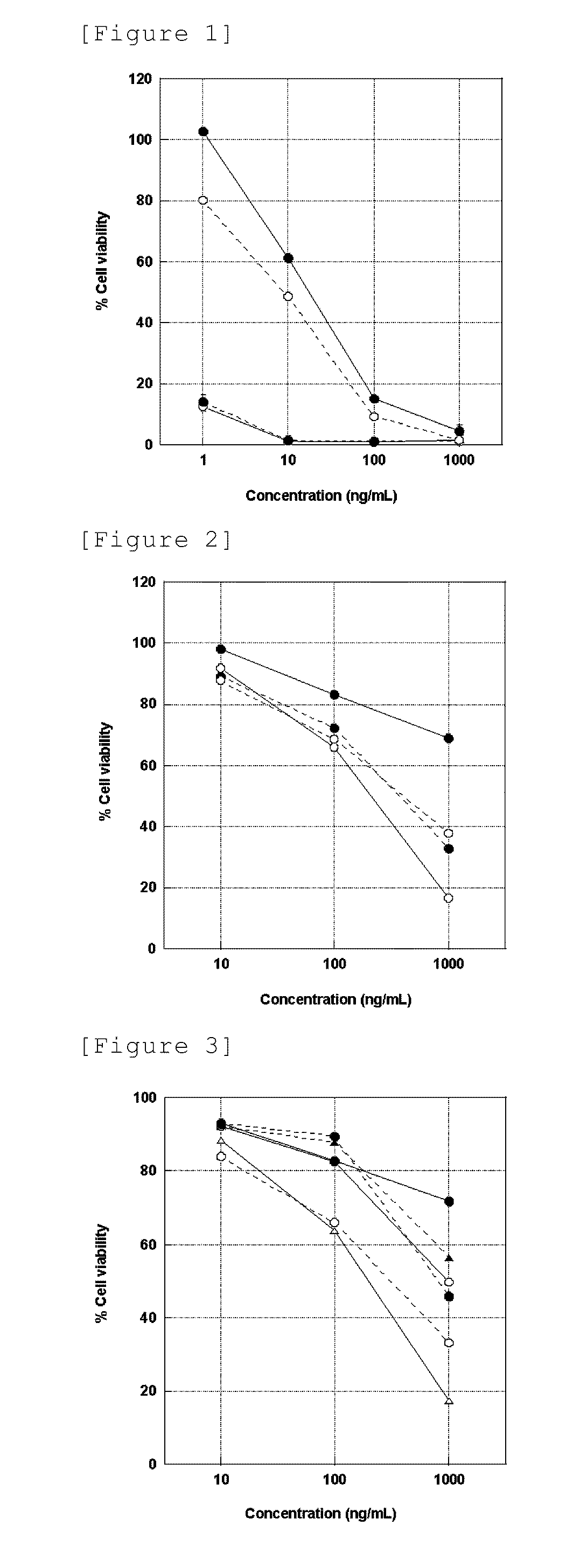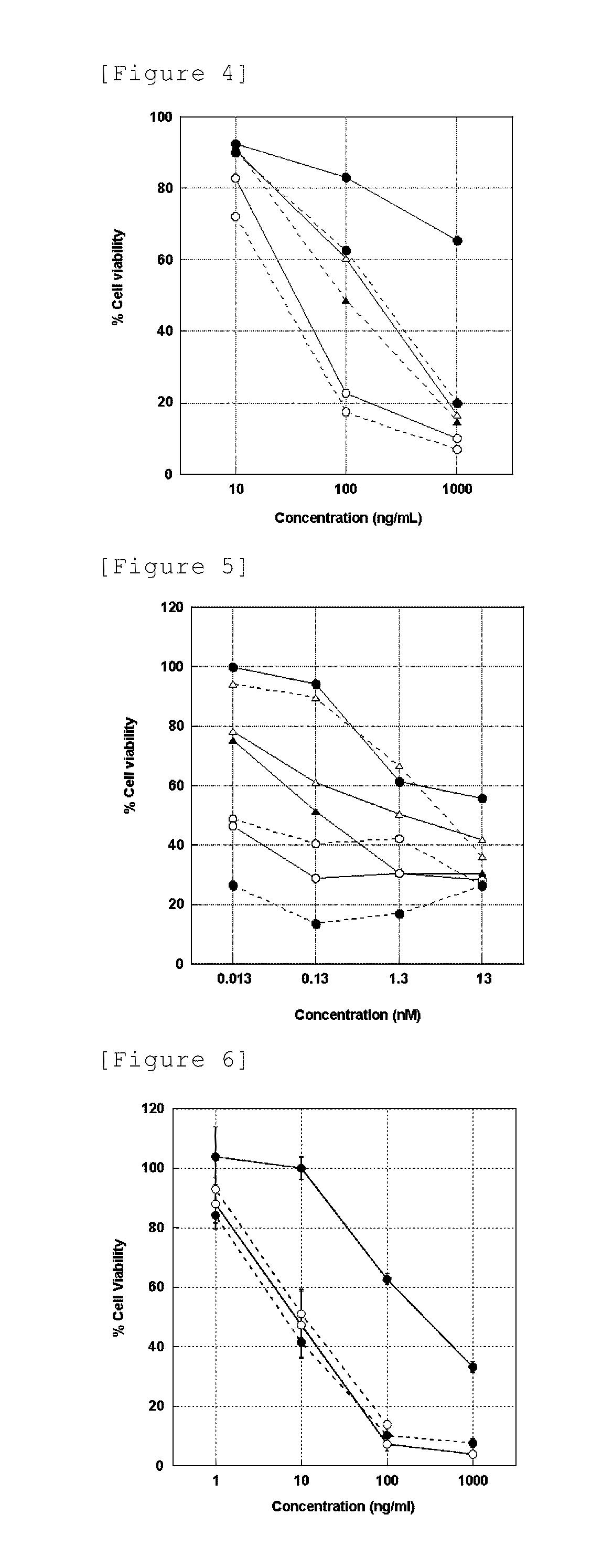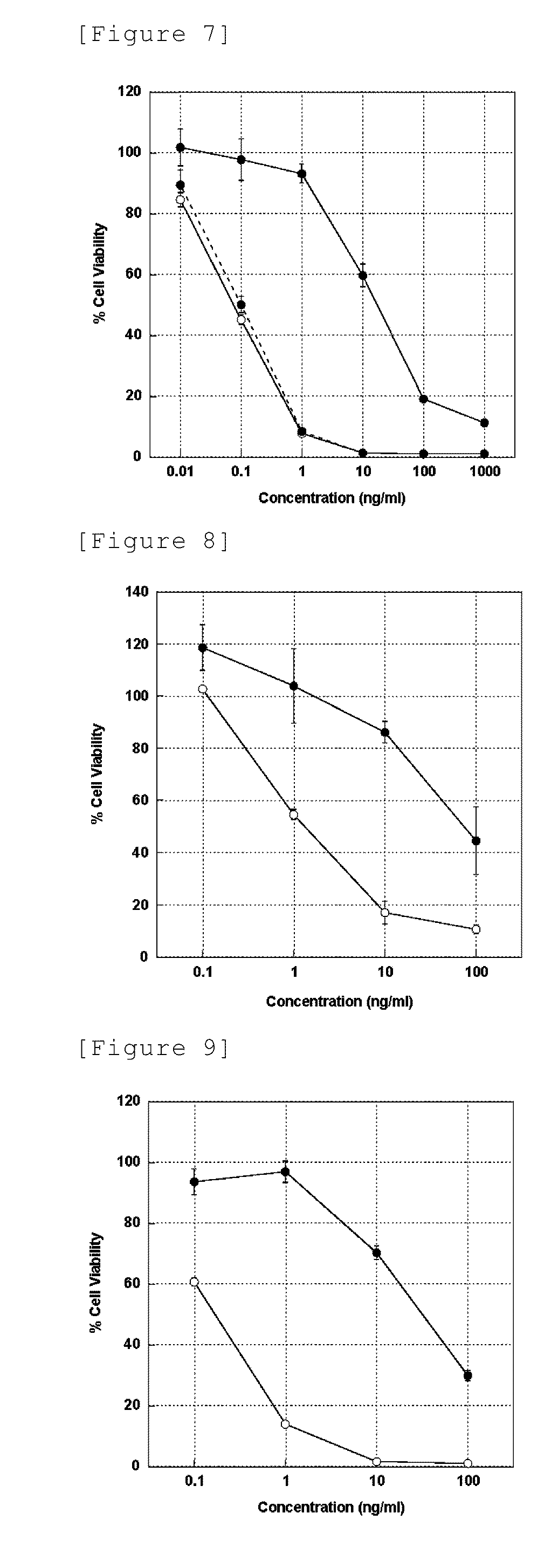Immunoliposome inducing apoptosis into cell expressing death domain-containing receptor
a technology of immunooliposome and cell, applied in the field of immunooliposome, can solve the problems of limited amount of drug that can actually reach the target site and exert its activity, large amount of drug lost in a solution, and liposomes have not been put in practical use so far
- Summary
- Abstract
- Description
- Claims
- Application Information
AI Technical Summary
Benefits of technology
Problems solved by technology
Method used
Image
Examples
reference example 1
Preparation of hTRA-8 F(ab′)2
[0447]The concentration of an anti-human DR5 antibody hTRA-8 was adjusted to 10 mg / ml with an acetate buffer (20 mM sodium acetate, pH 4.5). In this context, the hTRA-8 is an antibody obtained by humanizing a mouse anti-human DR5 antibody TRA-8 (Nature Med. 2001, 7 (8), 954-60) and has the amino acid sequence of SEQ ID NO: 1 described in the sequence listing as the heavy chain amino acid sequence and the amino acid sequence of SEQ ID NO: 2 described in the sequence listing as the light chain amino acid sequence. An amino acid sequence consisting of amino acid residues 1 to 118 of the amino acid sequence of SEQ ID NO: 1 described in the sequence listing corresponds to the heavy chain variable region of hTRA-8, and an amino acid sequence consisting of amino acid residues 1 to 107 of the amino acid sequence of SEQ ID NO: 2 described in the sequence listing corresponds to the light chain variable region of hTRA-8. To 1 ml of the present antibody solution, 1...
reference example 2
Preparation of hHFE7A F(ab′)2
[0448]The concentration of an anti-human Fas antibody hHFE7A was adjusted to 10 mg / ml with an acetate buffer (20 mM sodium acetate, pH 4.5). In this context, the hHFE7A is an antibody obtained by humanizing a mouse anti-human Fas antibody HFE7A (Int. Immunol. 2000, 12 (4), 555-62) and has the amino acid sequence of SEQ ID NO: 3 described in the sequence listing as the heavy chain amino acid sequence and the amino acid sequence of SEQ ID NO: 4 described in the sequence listing as the light chain amino acid sequence. An amino acid sequence consisting of amino acid residues 1 to 139 of the amino acid sequence of SEQ ID NO: 3 described in the sequence listing corresponds to the heavy chain variable region of hHFE7A, and an amino acid sequence consisting of amino acid residues 1 to 131 of the amino acid sequence of SEQ ID NO: 4 described in the sequence listing corresponds to the light chain variable region of hHFE7A. To 1 ml of the present antibody solution...
reference example 3
Preparation of hTRA-8 scFv
[0449](1) Preparation of hTRA-8 scFv Expression Vector
[0450]DNA encoding the first half of hTRA-8 scFv was amplified by PCR using vectors TRA-8-H pHA15-1 encoding a hTRA-8H chain region as templates for VH and two oligonucleotide primers.
[0451]Likewise, DNA encoding the latter half of hTRA-8 scFv was amplified by PCR using vectors TRA-8-L LM-1L encoding a hTRA-8 L chain region as templates for VL and two oligonucleotide primers.
[0452]In this procedure, primers were designed to add a flexible peptide linker (GGGGS)×3 between VH and VL and a sequence HHHHHHGGAC (sequence containing a six-histidine residue tag and a Cys residue) to the C terminus. Then, to these DNA fragments, 5′ NdeI (TAKARA BIO INC.) and 3′ XhoI (TAKARA BIO INC.) sites were inserted, and the resulting fragments were ligated by PCR to prepare hTRA-8 scFv-encoding DNA.
[0453]The prepared DNA was digested with restriction enzymes NdeI and XhoI and then inserted into the restriction sites NdeI / Xh...
PUM
| Property | Measurement | Unit |
|---|---|---|
| particle size | aaaaa | aaaaa |
| particle size | aaaaa | aaaaa |
| time | aaaaa | aaaaa |
Abstract
Description
Claims
Application Information
 Login to View More
Login to View More - R&D
- Intellectual Property
- Life Sciences
- Materials
- Tech Scout
- Unparalleled Data Quality
- Higher Quality Content
- 60% Fewer Hallucinations
Browse by: Latest US Patents, China's latest patents, Technical Efficacy Thesaurus, Application Domain, Technology Topic, Popular Technical Reports.
© 2025 PatSnap. All rights reserved.Legal|Privacy policy|Modern Slavery Act Transparency Statement|Sitemap|About US| Contact US: help@patsnap.com



